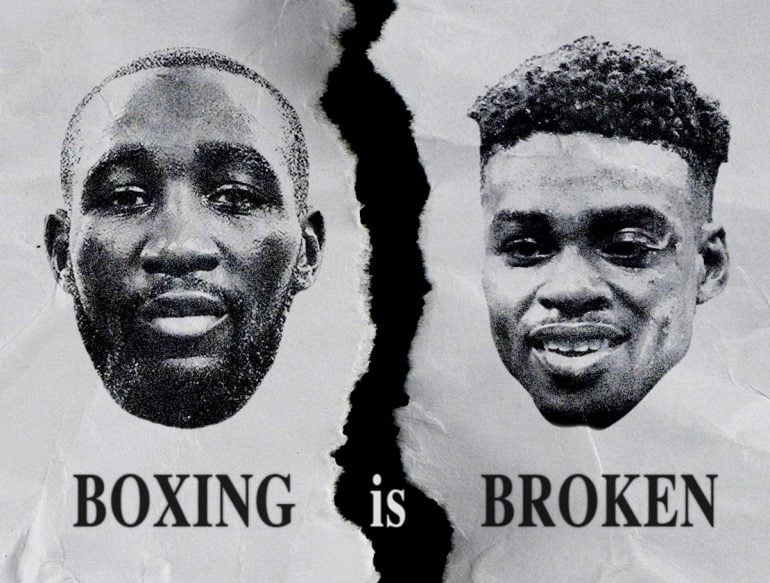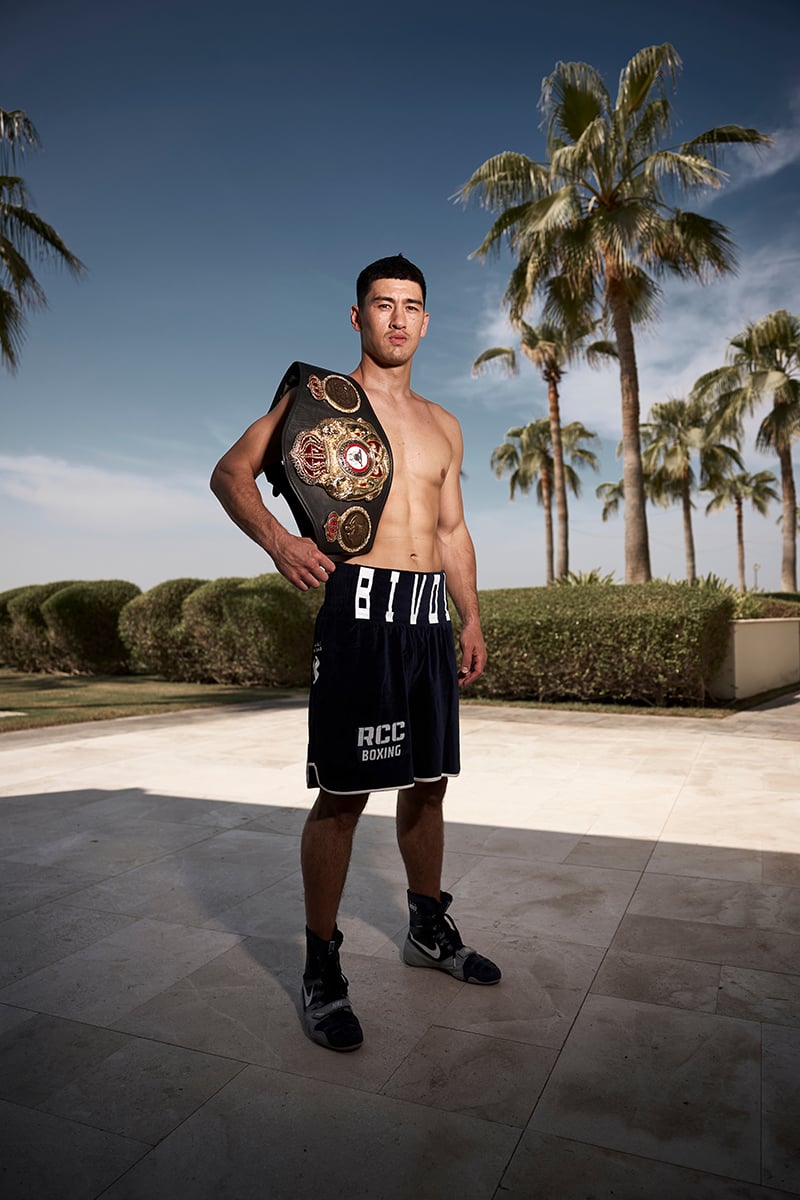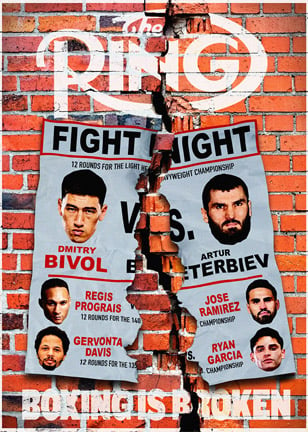
Above: There’s always some behind-the-scenes reason why Terence Crawford (left) and Errol Spence Jr. aren’t facing each other in the ring.
(HOW DO WE FIX IT?)
PART 1: THE NETWORK DIVIDE
Let’s get this out of the way – there is no way to “fix” boxing. The stark reality is that it’s far beyond the point of being fixed in any meaningful way. The business is simply too fractured for it to ever really become what it once was. Truth be told, even during its heyday boxing was flawed. But that was part of its charm, which both amused and infuriated those who followed the sport.
These days, boxing is more of a business than a sport, and business is not good.
However, as Larry Merchant once famously said: “Nothing’s going to kill boxing, and nothing’s going to save it.”
We here at The Ring are realists, but we’re also optimistic enough to try to offer solutions to the many things that currently plague both the sport and business. So, in what will be an ongoing series, we will take a pragmatic approach to figuring out how boxing can be improved from a structural standpoint.
Part one of this series is dedicated to a particular situation that keeps more meaningful fights from occurring than any other problem: the network divisions, which have in essence created separate leagues within the sport.
Bottom line: Too many fights are not being made for all the wrong reasons.
As you peer out at the landscape of boxing, you see that the sport is televised regularly in the U.S. on ESPN, Showtime and DAZN. The three platforms have a regular rotation of fight cards and have invested millions into the industry.
The problem with this investment is the promotional exclusivity that comes with it. Top Rank is the exclusive content provider for ESPN (and their streaming platform ESPN+). Premier Boxing Champions (PBC) is aligned with Showtime. And DAZN only works with Matchroom Sports and Golden Boy Promotions. The sport is essentially split between three separate universes.
While it’s convenient for both the networks and the promoters to be able to consistently showcase and develop their talent on one network that will guarantee dates for them, there is a downside that comes with this. As standout boxers become stars on competing platforms, there comes the inevitable battle to match them against their colleagues who have been nurtured by other promoters on rival networks.

The “truth” is that fans aren’t seeing Errol Spence Jr. vs. Terence Crawford because both sides want more money and more control.
The biggest example we can point to recently is the situation involving unified (WBA, WBC and IBF) welterweight titleholder Errol Spence and WBO beltholder Terence Crawford. Spence, The Ring’s No. 1-rated welterweight, is represented by the PBC and seen on Showtime and Fox (when the promotional company still had a relationship with the network), while Crawford, The Ring’s No. 2-rated welterweight, was an ESPN staple when he was under the Top Rank banner (which ceased at the end of 2021). This clash has been talked about for years, but it still has not come to fruition.
Spence spoke openly about his rival being on ”the wrong side of the street.” Which is really the crux of the issue. Even now, as Crawford is a free agent, this fight wasn’t made in 2022. One of the problems is that both boxers were paid handsomely against lesser opponents for years – in part because they were bound to exclusive networks that viewed them as pillars of their boxing franchises. Each wants to be paid a fortune and have significant control over the promotion in order to share the ring.
Bottom line: Too many fights are not being made for all the wrong reasons. The reality is that once a network or streaming app pours years’ worth of resources into a fighter, the promoter is basically beholden to them to keep them there – even at the expense of lucrative opportunities that may exist elsewhere.

Roy Jones Jr. was HBO’s cash cow for years.
About a decade ago, a highly anticipated duel between unbeaten bantamweights Nonito Donaire and Abner Mares never took place as Top Rank and Golden Boy waged their “cold war” (which has fortunately since thawed). Top Rank believed that it should have control of this bout and put it on HBO, while Golden Boy wanted it on Showtime, with whom they were working almost exclusively.
During his prime as a poster boy for HBO’s boxing programming, Roy Jones simply could not go over to Showtime to face British stars Chris Eubank, Nigel Benn and Joe Calzaghe, because after investing so heavily in Jones for years against nondescript opposition (remember his super middleweight and light heavyweight title defenses against the likes of Bryant Bannon, Otis Grant, Ricky Frazier, David Telesco, Richard Hall, Derrick Harmon and Glenn Kelly?), the executives at the premium cable network simply couldn’t afford to see him face live competition elsewhere. So it was just better to keep spotlighting Jones in what were basically one-man concerts. He was as integral to HBO Sports as The Sopranos was to their primetime fare.
There are countless other examples of broadcast exclusivity rendering marquee bouts into non-starters. For all the well-deserved heat the sanctioning bodies have taken throughout the years, network deals have kiboshed more significant fights than the alphabet boys have; especially as promoters have begun to value protecting their platform partners more than servicing the fight fans.
However, it has to be pointed out that we have seen some co-promotions in recent years, such as the ESPN/Top Rank-Fox/PBC alliance that allowed Tyson Fury and Deontay Wilder to fight for the second and third times. Arch-rivals Don King and Bob Arum consummated the welterweight superfight between Felix Trinidad and Oscar De La Hoya in 1999 on HBO Pay-Per-View. The money involved was simply too great to not make these bouts a reality.
And back in 2019, when upstart platform DAZN still had a full war chest of money, Top Rank had no qualms about sending Jose Ramirez over to face Maurice Hooker in a WBC/WBO junior welterweight unification bout to earn an exorbitant payday that otherwise wouldn’t be available on ESPN.

Why can’t Jose Ramirez (left, pounding Maurice Hooker) get in a ring with Regis Prograis?
Speaking of Ramirez, fast-forward to 2023. The now-former beltholder had an opportunity to face newly crowned WBC 140-pound titlist Regis Prograis as the WBC’s mandatory challenger. But he balked at the 35 percent split he would have received for that bout if it went to a purse bid. Top Rank never really made an attempt to negotiate that bout with Prograis’ promoter (Probellum), and instead made a fight for Ramirez on March 25 in his hometown of Fresno, California, against the faded Richard Commey.
To put it bluntly, Prograis is simply too risky a proposition for Ramirez, who had the safety net of being with a promoter who has an exclusive content deal with ESPN. Probellum does not. But you wonder if anyone at the network balked at the fight they are televising on this date. Nobody could argue in good conscience that Ramirez-Commey isn’t a far-inferior bout compared to Prograis-Ramirez.

Dmitry Bivol was the consensus Fighter of the Year in 2022, yet somehow the powers-that-be don’t see enough value in a matchup with light heavyweight powerhouse Artur Beterbiev. (Photo by Mark Robinson Matchroom Boxing)
Other marquee matchups like Artur Beterbiev-Dmitry Bivol, which would be for the undisputed light heavyweight championship, are still being bogged down by the issue of which network will have the rights to air it. Beterbiev, who is promoted by Top Rank, is bound to ESPN, while Bivol, who is represented by Matchroom Sports, is a staple of DAZN.
The problem with this particular bout is that while it’s certainly a pairing that delights hardcore fans, it doesn’t have nearly the appeal to the casuals, meaning it won’t gain much traction as a pay-per-view event.
Then you have the Gervonta Davis-Ryan Garcia bout, which is being bandied about for April 15. There were certainly hurdles to overcome here, given the parties involved. The real impetus for this anticipated showdown was that both boxers pushed hard for it to occur. Unlike most fighters, they actually have the cache to push their promoters in a certain direction, due to their box-office appeal.
The last impediment to making this fight official? You guessed it: a network issue. Golden Boy Promotions is insisting that, should Garcia come out victorious, DAZN would get rights to the rematch, as Showtime and PBC are taking the lead for the initial encounter. This particular issue nearly derailed the fight.
In the future, there will be other instances where network alliances and rivalries will stand in the way of high-profile bouts from occurring. This isn’t so much about prizefighting but platform protection, in many instances.
What can be done about this?
Well, the solution is simple, if not realistic. The next network or streaming entity that decides to get into this game should think about FIGHTS, not fighters or promoters. They should reserve dates for no one promoter, but simply the best bout that is presented to them. Currently we are not getting the best fights that can be made in boxing, for the most part, but rather the most convenient bouts that are available from a particular promoter’s roster of boxers.
Perhaps a network can create a guardrail against regular mismatches by employing a boxing czar, such as veteran promoter Lou DiBella was during his days as an executive at HBO. This individual would in essence approve the fights or at times serve as the de facto matchmaker. Some may push back on this idea, but keep this in mind: It is the networks’ license fees that really fund these cards, so the networks should have some say in their programming.
And if an amicable resolution cannot be negotiated by two competing parties, they should just put the fight up for a purse bid and see which network really wants a particular bout.
This way everyone wins. The boxers get paid well, and the fans get a fight they want.
Do you agree with Steve Kim’s take and/or solution to boxing’s “network divide”? Is there a particular problem in boxing that you’d like him to tackle? Email your opinions, rants and solutions to [email protected].

Steve Kim is on Instagram and Twitter:

